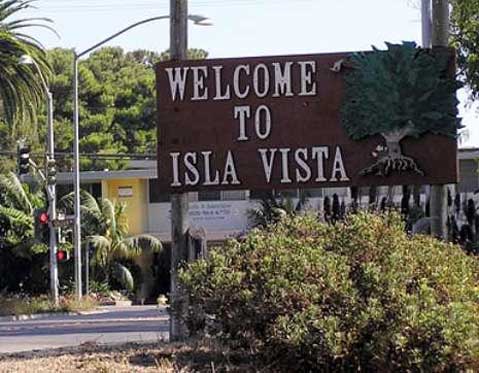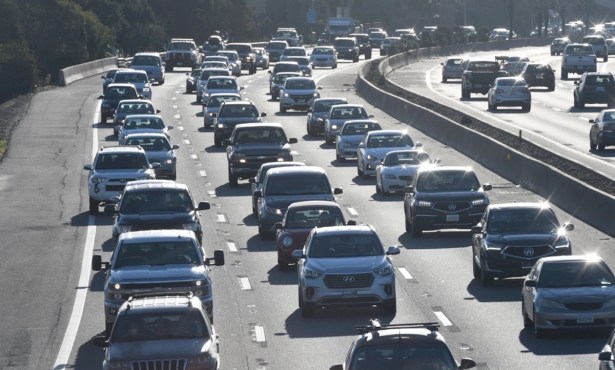A Month of Sundays
Imagine Transforming Isla Vista Into a Car-Free Area

Early Sunday morning is the best time for running or walking, which I do for exercise mostly, though it is a great opportunity for thinking and consideration. Running and walking are best when motor vehicle traffic is minimal or non-existent.
As I run, I sometimes think about how nice it is to be separated from cars. Not having to think about getting hit or killed by a car or truck allows for more free thought. Sundays or not, I find myself plotting out runs based on trying to stay away from vehicles. I search for the dirt shoulders that run next to bike paths, the beach, trails, and other car-free zones.
I got to thinking about the relationship of pedestrians, runners, and bikers with cars and trucks. We as a society have certainly supported the accommodation of the automobile into our physical world. I suppose it has served us adequately for a number of years. As we progress as a society, however, we can certainly improve on the current situation. Much time and effort goes towards bettering our lives in many other areas, through research and development, technology, medical advances, etc. It seems to me not enough thought and consideration is being directed towards how we live and interface with motor vehicles.
An amazing number of roads allow us to get pretty close to almost anyplace. Too close, some of us believe. Roads and car storage require a lot of land, an amazing amount really. Motor vehicles take up quite a lot of any given site, whether it be an entire city, a residential area, a commercial, institutional, or industrial area. To illustrate this point, I am a development-team member working on a proposed project in Isla Vista. The space dedicated to buildings and outdoor (landscaped and pedestrian areas) space is very nearly equal to the amount of land devoted to parking and driveway. It is very close to 50:50. The concept of dedicating (required by county planning) that amount of space to cars should be debated. The cost of containing so many cars on site is very considerable when land values and the finite nature of coastal land is considered. This issue has a large bearing on affordability.
What can be done differently? There are parts of the country and world where planners and designers have done things differently, and I think better. In Bend, Oregon, and Celebration, Florida, cars approach houses from the rear. Garages are in the back, accessed by an alley. Cars are recognized as being useful, but are relegated to the rear. People are given the priority they deserve in front of the houses and these areas are pedestrian only.
Other versions of this concept still have a street in front, but no parking is allowed on the street or in the front of the houses. Parking is allowed in certain grouped areas; some walking is required of visitors. This design sets up great spaces dedicated to people, not cars and trucks. In Zermatt, Switzerland, cars are not permitted: People arrive only by train. People walk mostly, as distances are short. For deliveries and light construction and maintenance, electric carts of various sizes are used; pedestrians have the right of way. I suppose actual trucks can be available for moving and delivery of large items. This car-free environment offers pedestrians a wonderful, safe, quiet, and pollution-free experience.
Imagine transforming Isla Vista into a car-free area. Imagine allowing building owners to remove their parking lots and driveways. County planning could allow new residential units to be built on perhaps half of this reclaimed space, while the other half could be open space for people’s enjoyment, patios, sport courts, pools, spas, etc. Property tax from these new units would be directed towards a common people-moving trolley that would be installed. One trolley route would run east-west through the center of I.V. right into the middle of campus. Another line would run north-south connecting the Isla Vista community to remote parking lots and a transit hub. Here students could store a car, for times when cars are necessary. Other amenities at the end of this line might include: bus station, taxi, car rental, shuttle to airport and downtown.
The streets of Isla Vista would be maintained as is, but used mostly by bicycles, pedestrians, and perhaps electric delivery carts. Emergency vehicles could still use the streets as necessary. One day each week cars and trucks could be allowed in, for moving and heavier deliveries. Imagine Isla Vista without cars and car storage: Substantial additional density could be added without creating sprawl. Think about how much money could be saved by students who currently maintain cars in Isla Vista for three to five years. These are exciting ideas.
I do not advocate changing every existing neighborhood to the vision examined above. People should be entitled to a choice with regard to how intimate a relationship they wish to have with motor vehicles. I believe we need to begin to explore other ways of building and living. Designers should propose conceptual plans and share them with the public and with government.
We must remain open to new ideas, not be so quick to say no. We must be more creative. We must find the will to compete with the powerful lobbies that crush ideas that deviate from the status quo. I and others would like to participate in forums or design competitions that could begin to offer us alternatives to car culture; this is how change can begin to occur. Governments must change, too: New ideas should not be ignored in favor of the status quo just because that is easier.
Consider that our physical environment looks and functions the way it does because we have been lulled into believing that the automobile is such an indispensable tool that we have allowed it to take over. Next time you are out, look around an imagine alternatives. If you get a chance, visit one of these pedestrian-first communities and see what it is about.
Charles McClure is a landscape architect who lives, works, drives, and goes on foot in Santa Barbara.



